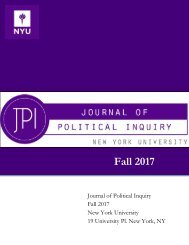JPI Spring 2018
Create successful ePaper yourself
Turn your PDF publications into a flip-book with our unique Google optimized e-Paper software.
commander of Belgrade ordered Christians to defend themselves against the defiant janissaries. 40 After<br />
the unrest, reprisals against Christians sparked the Second Serbian Uprising of 1815, which resulted<br />
in greater Serbian autonomy. 41 The rebellion occurred within the border zone between the Habsburg<br />
and Ottoman empires. Many of its leaders and participants had gained military experience and training<br />
in previous battles between the Ottoman Empire and European powers. Discontent primarily derived<br />
from a breakdown of basic law, order, and societal predictability. When combined with Russia’s 1806<br />
plea to join in a war against the Ottomans as well as earlier conceptions of Serbian identity, the<br />
reactionary loyalist rebellion evolved into a struggle for independence. 42<br />
While contemporary nationalism contributed to the revolt as it developed and garnered<br />
support from external forces, most Serbian intellectuals of the time lived, studied, and wrote within<br />
the Habsburg Empire. Additionally, records indicate that only 0.5% of Christians in Belgrade on the<br />
eve of Serbia’s autonomy could read, suggesting that consumption of nationalist literature did not<br />
contribute to the reinforcement of nationality. 43 An identity developed over centuries and rooted in<br />
Christianity, the Serbian language and territorial expansion distinguished Serbs from their Ottoman<br />
administrators. As Rusinow suggests, contemporary conceptions of the nation-state modernized<br />
proto-nationalist Balkan societies into their current form.<br />
In The Bridge on the Drina, Andrić illustrates proto-national identities through scenes of epic<br />
poetry referencing the Serbian Empire in the presence of the peasant classes. In one passage, a<br />
traveling Montenegrin plays his gusle (a bowed lyre) and sings to the Christian bridge laborers about<br />
the Serbian Tsar Stefan two hundred years before the arrival of contemporary nationalism. 44 Later in<br />
the novel, Višegrad’s Christian peasants alter earlier poems and songs to glorify the 19 th -century<br />
Serbian uprisings. The interpretations of external political events further divided the town’s citizens.<br />
In observing the Serbian revolts, “Serbs prayed to God that these saving flames … should spread to<br />
these mountains, while the Turks prayed to Allah to hold their progress and extinguish them, to<br />
frustrate the seditious designs of the infidel and restore the old order and the peace of the true faith.” 45<br />
DRIVERS OF CONTEMPORARY CHRISTIAN NATIONALISM AND THE MUSLIM<br />
‘DELAY’ IN BOSNIA<br />
As the proto-nationalist societies of Bosnia evolved their ideology to resemble Western<br />
European nationalism, several consequences of Ottoman rule drove the process. Revolutionaries<br />
founded their stances on attitudes toward the Ottoman and Austro-Hungarian legacies, the results<br />
of Ottoman agrarian control and land distribution, and the ideological consequences of external<br />
geopolitical influences, primarily emanating from Western Europe and Russia.<br />
Regarding land distribution, in 1895 Turks owned 50% of arable land in Rumelia, the area of<br />
southeastern Europe administered by the Ottomans. 46 At the end of Ottoman rule in Bosnia, forty of<br />
the largest landowners were Muslim. Conscious of the divergence, in 1856 the Sublime Porte issued a<br />
reform edict to abolish religious inequality, which the Ottomans subsequently retracted due to Muslim<br />
40<br />
Ibid., 578.<br />
41<br />
Frederick F. Anscombe, "The Balkan Revolutionary Age," Journal of Modern History 84, no. 3 (September 2012): 574-578, Historical Abstracts with<br />
Full Text, EBSCOhost (accessed November 20, 2017).<br />
42<br />
Ibid., 587-588.<br />
43<br />
Ibid., 600.<br />
44<br />
Ivo Andrić, The Bridge on the Drina (Chicago: University of Chicago Press, 1977), 34.<br />
45<br />
Ivo Andrić, The Bridge on the Drina (Chicago: University of Chicago Press, 1977), 83.<br />
46<br />
A. Bebler, "Turkey's Imperial Legacy and the Potential for Conflict in the Balkans," Politicka Misao 53, no. 4 (March 1, 2017): 162, Scopus®,<br />
EBSCOhost (accessed November 20, 2017).<br />
<strong>JPI</strong> Fall 2017, pg. 14
















